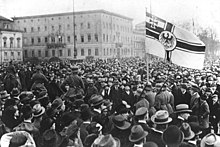
Back انقلاب كاب Arabic Каповски пуч Bulgarian Putsch Kapp Breton Kappův puč Czech Kappkuppet Danish Kapp-Putsch German Πραξικόπημα του Καπ Greek Puĉo de Kapp Esperanto Golpe de Estado de Kapp Spanish Kappen Putscha Basque
| Kapp Putsch | |||||||
|---|---|---|---|---|---|---|---|
| Part of political violence in Germany (1918–1933) | |||||||
 Marinebrigade Ehrhardt entering Berlin during the Putsch | |||||||
| |||||||
| Belligerents | |||||||
|
|
| ||||||
| Commanders and leaders | |||||||
|
|
| ||||||
The Kapp Putsch (German pronunciation: [ˈkapˌpʊt͡ʃ] ), also known as the Kapp–Lüttwitz Putsch (German pronunciation: [kapˈlʏtvɪt͡sˌpʊt͡ʃ] ), was an attempted coup against the German national government in Berlin on 13 March 1920. Named after its leaders Wolfgang Kapp and Walther von Lüttwitz, its goal was to undo the German Revolution of 1918–1919, overthrow the Weimar Republic, and establish an autocratic government in its place. It was supported by parts of the Reichswehr, as well as nationalist and monarchist factions.
Although the legitimate German government was forced to flee the city, the coup failed after a few days, when large sections of the German population joined a general strike called by the government. Most civil servants refused to cooperate with Kapp and his allies. Despite its failure, the Putsch had significant consequences for the future of the Weimar Republic. It was also one of the direct causes of the Ruhr uprising a few weeks later, which the government suppressed by military force, after having dealt leniently with leaders of the Putsch. These events polarized the German electorate, resulting in a shift in the majority after the June 1920 Reichstag elections.
© MMXXIII Rich X Search. We shall prevail. All rights reserved. Rich X Search